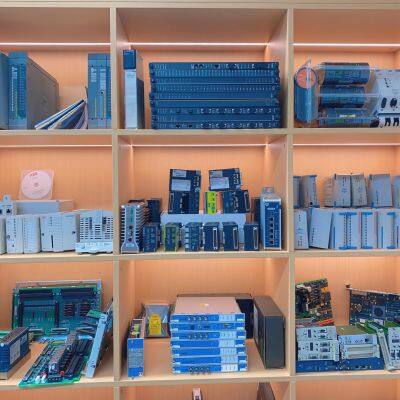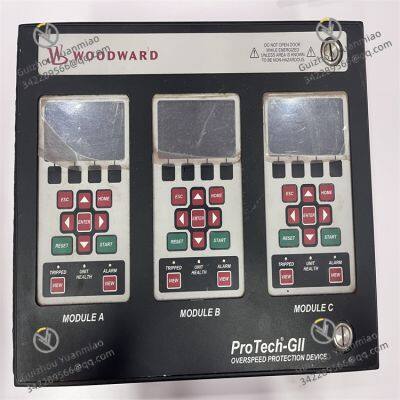Product Description
I. Product Overview
WOODWARD 8237 - 1246, as a member of the ProTech - GII series, is a configurable overspeed detection system that plays a crucial role in ensuring safety in the industrial energy sector. Its core mission is to safeguard the operational safety of various turbines, including common steam turbines, gas turbines, and hydraulic turbines. Once it detects dangerous situations such as abnormally high rotational speed or excessive acceleration, it can respond quickly to safely shut down the turbine, effectively avoiding equipment damage or even catastrophic accidents caused by overspeed, thus building a solid defense for the stable operation of industrial production.
It adopts a compact and robust structural design. Although the specific size information is not available yet, referring to the design ideas of the same series of products, its appearance is likely to be optimized to flexibly adapt to installation environments with different spatial layouts. Whether it is the equipment room of a small power station with relatively limited space or the complex power system area in a large industrial plant, a suitable installation position can be found. In terms of weight, the 8237 - 1246 is lightweight and portable. According to data, its weight is less than 27 pounds, which not only greatly reduces the labor handling cost during installation but also makes equipment maintenance and replacement more convenient and efficient, reducing the operational difficulties caused by the heavy weight of the equipment.
II. Performance Characteristics
(1) Overspeed and Acceleration Detection Functions
Precise overspeed detection: WOODWARD 8237 - 1246 has extremely precise overspeed detection capability and can monitor the rotational speed of the turbine in real - time. It adopts advanced sensor technology and sophisticated algorithms to conduct high - speed collection and analysis of the turbine's rotational speed signals, enabling it to quickly and accurately determine whether the turbine is in an overspeed state. Once it detects that the turbine's rotational speed exceeds the preset safety threshold, the system will immediately trigger the corresponding protection mechanism and issue a shutdown command to stop the turbine as quickly as possible, thereby avoiding serious accidents such as mechanical component damage and runaway caused by overspeed. This precise overspeed detection capability provides the first reliable line of defense for the safe operation of the turbine.
Efficient acceleration detection: In addition to precise control over overspeed, this product also has an excellent acceleration detection function. It can Acute ly capture abnormal changes during the acceleration process of the turbine. By accurately calculating the derivative of the rotational speed signal, it can promptly detect whether the turbine is accelerating too fast. In industrial production, certain sudden situations may cause the turbine to accelerate instantaneously. If not detected and controlled in time, it will also cause great damage to the equipment. The acceleration detection function of the 8237 - 1246 can detect such abnormal acceleration in the first place and take prompt actions to safely shut down the turbine, effectively protecting the equipment from the impact and damage caused by abnormal acceleration.
(2) Multiple Protection Performances
MPU detection: To ensure the reliability and stability of the system itself, WOODWARD 8237 - 1246 is equipped with an MPU detection function. Before the turbine operates, the system will automatically conduct a comprehensive self - inspection of the Microprocessor Unit (MPU), checking whether the hardware connection of the MPU is normal and whether the software program runs stably, to ensure that the entire detection system is in the best working state when the turbine starts. During the operation of the turbine, the MPU detection function will also continuously monitor the working condition of the MPU. Once a fault or abnormality is found in the MPU, the system will immediately issue an alarm and take corresponding measures, such as switching to a standby detection channel or stopping the turbine operation, to ensure the safe and reliable operation of the entire system.
Resistance to gas corrosion: In some industrial environments, especially in fields such as petrochemicals and energy extraction, equipment often faces harsh working conditions with corrosive gases such as sulfur, hydrogen sulfide (H?S), and sulfur dioxide (SO?). WOODWARD 8237 - 1246 has been specially designed for this situation, using special protective materials and processes, so that it has excellent resistance to gas corrosion. Even if it is in an environment with these corrosive gases for a long time, the electronic components and circuits inside the equipment can be effectively protected, and there will be no performance degradation or damage due to gas corrosion, which greatly prolongs the service life of the equipment and improves its reliability and stability in harsh environments.

(3) Modular Design and Scalability
Triple modular design: The 8237 - 1246 adopts a unique triple modular design concept, which makes the product have high flexibility and maintainability during operation. The three independent modules undertake different functions, cooperating with each other and being independent of each other. When one of the modules fails, there is no need to shut down the entire equipment for large - scale maintenance. Operators can directly and quickly replace the faulty module while the equipment is running, which greatly shortens the downtime of the equipment and improves production efficiency. At the same time, this modular design also facilitates the upgrading and expansion of the equipment. Users can flexibly add or replace modules with specific functions according to actual needs to meet the changing production process requirements.
Scalability: With the continuous development of industrial production and the continuous progress of technology, the functional requirements for equipment are becoming more and more diversified. WOODWARD 8237 - 1246 has fully considered scalability at the beginning of its design, reserving rich interfaces and expansion space. Users can conveniently add expansion components such as communication modules, data storage modules, and additional sensor interfaces according to actual production needs, so that the equipment can better integrate with other industrial automation systems and realize more complex control and monitoring functions. For example, by adding a communication module, the equipment can be connected to the factory's central control system to realize remote monitoring and data transmission, making it convenient for operators to grasp the operation status of the equipment anytime and anywhere and make timely decisions.
(4) Electrical Performance
Wide voltage input: This product has strong adaptability in terms of electrical input and supports a wide voltage input range. Its high - voltage input can work stably under the conditions of 90 - 264VAC (alternating current voltage) with a frequency of 47 - 63Hz, or 100 - 150VDC (direct current voltage) with a power of 30W per module. This wide voltage input characteristic enables it to adapt to the power supply conditions of different industrial sites. Whether it is a remote area with large grid voltage fluctuations or a special industrial environment with different power standards, the 8237 - 1246 can operate stably, reducing the risk of equipment failure caused by voltage mismatch or voltage fluctuation.
Multiple output voltage options: In terms of output voltage, WOODWARD 8237 - 1246 provides a variety of options to meet the needs of different equipment and application scenarios. Its nominal high output voltages include 115VAC, 240VAC, and 125VDC, and the nominal low output voltage is 24VDC. This multi - output voltage design enables the product to flexibly match various types of actuators, control equipment, etc., facilitating users to carry out reasonable configuration according to the actual electrical system architecture and equipment requirements, and ensuring the electrical compatibility and stability of the entire system.
(5) Testing and Diagnostic Functions
Routine testing function: To ensure that the equipment is always in good working condition, WOODWARD 8237 - 1246 has a routine testing function. Users can conveniently start routine tests on each independent module through the equipment's operation interface or an external control system. During the test, the system will simulate various actual operating conditions to comprehensively detect various performance indicators of the module, including the accuracy of the sensor, the stability of the signal processing circuit, the correctness of the control logic, and the response capability of the output actuator. Through such regular routine tests, potential fault hidden dangers can be found in time, and corresponding measures can be taken for repair, avoiding sudden faults in actual operation that affect the normal progress of production.
Fault diagnosis and recording: When the equipment detects a fault or abnormal situation, WOODWARD 8237 - 1246 will immediately start the fault diagnosis program to quickly analyze and locate the cause of the fault. It can not only accurately determine the specific location and type of the fault, such as sensor failure, circuit short circuit, module communication abnormality, etc., but also record in detail the time of the fault occurrence, relevant parameters, and the operation status before and after the fault. These rich fault diagnosis and recording information provide valuable reference for equipment maintenance personnel, helping them quickly and accurately carry out fault Investigation and repair, greatly shortening the equipment maintenance time and improving the availability of the equipment.
III. Installation Steps
Preparation before installation: Before installing WOODWARD 8237 - 1246, a comprehensive and detailed inspection of the product should be carried out first. Carefully check whether the appearance of the product is damaged, deformed, or has missing parts, ensuring that the shell is not damaged, the display screen has no scratches, and the interfaces are not deformed. At the same time, compare with the product packing list, carefully check whether the product model, specifications, and the number of accessories are accurate, to avoid affecting the installation progress due to incomplete accessories or inconsistent models. In addition, it is necessary to confirm that the installation environment meets the requirements. The installation location should be dry and well - ventilated, away from strong electromagnetic interference sources and corrosive substances. The ambient temperature should be controlled within the operating temperature range specified by the product, which is - 4°F to 140°F (approximately - 20°C to 60°C), and the humidity should also meet relevant standards to ensure that the equipment can operate normally and stably. At the installation site, necessary installation tools such as screwdrivers, wrenches, wire crimpers, and multimeters should be prepared, and ensure that the tools are in good condition and meet the accuracy standards.
Electrical connection operation: Carry out electrical connection operations in strict accordance with the electrical installation drawings to ensure that the wiring is accurate and firm. During the connection process, carefully distinguish the functions of different terminals to avoid electrical faults caused by wrong wiring. For the connection of the power line, select the appropriate specification of the wire according to the voltage input requirements of the equipment, and ensure that the wire diameter meets the current - carrying capacity of the equipment. When wiring, it must be firm and reliable to prevent heating or even fire due to poor contact. When connecting the signal line, pay attention to the correct connection of the shielded wire to reduce the impact of electromagnetic interference on signal transmission. For some special interfaces, such as communication interfaces and sensor interfaces, extra care should be taken during connection, and operations should be carried out in accordance with the operating procedures to ensure that the interfaces are connected tightly without looseness, so as to avoid damaging the interfaces or affecting the signal transmission quality. After the connection is completed, use a multimeter to test the conductivity of the connected lines, check whether there are problems such as open circuits and short circuits in the lines, and ensure the reliability of the electrical connection.
Equipment fixing and installation: Install WOODWARD 8237 - 1246 accurately at the predetermined position according to the installation requirements of the equipment. If the equipment needs to be installed in a cabinet, reasonably plan the installation position to ensure that there is enough space around the equipment for heat dissipation and maintenance. Use appropriate installation brackets and fixing bolts to firmly fix the equipment at the installation position to ensure that the equipment will not shake or shift during operation. When fixing the equipment, tighten the bolts according to the specified torque to avoid poor contact of the equipment or safety accidents caused by loose bolts. After the installation is completed, check the installation status of the equipment again to ensure that the equipment is installed firmly, in the correct position, and all interfaces are connected tightly without looseness.
BENTLY 1900/65A-00-00-01-00-01 General Purpose Equipment Monitor
Bently 3500/05-01-03-00-00-00 System Rack
BENTLY 190782-01 Communication Gateway Module
Bently 323174-01 Emergency Shutdown Device
ABB PPD513A-23-111615 magnetic excitation controller
TRICONEX Safety Instrumented System (SIS) 4351B control module


Bentley Nevada 3500/22M Transient data interface module
Bently Nevada 3500/15-05-05-00 power module
Triconex 3009 processor module
ABB GFD563A102 3BHE046836R0102 Excitation Convection Interface Module
ABB PPD117A3011 3BHE030410R3011 Excitation Controller
ABB PCD231B101 3BHE025541R0101 Excitation Unit Controller
ABB 5SHY3545L0010 3BHE009681R0101 High-Voltage Thyristor Module
ABB PCD230A 3BHE022291R0101 Controller Module
ABB 5SHY3545L0009 3BHB013085R0001 IGBT Module
Bently Nevada 3500/25 enhanced key phase module
Bently Nevada 3500/32 4-channel relay module
ABB PCD232A 3BHE022293R0101 Exciter Control Module
 yezi
Hi there! Welcome to my shop. Let me know if you have any questions.
yezi
Hi there! Welcome to my shop. Let me know if you have any questions.


